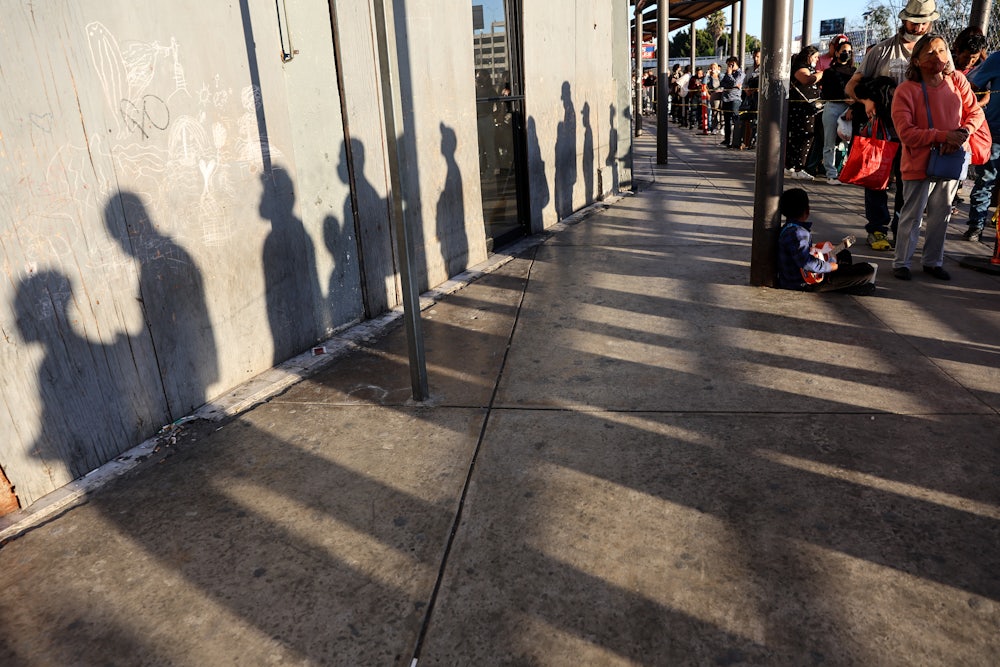When advocates lament President Joe Biden’s timidity towards or outright embrace of Donald Trump’s immigration legacy, they often point to one policy that stands as the exemplar of his dereliction: the CDC’s prolongation of Title 42, an order issued under an obscure provision of U.S. public health law that was ostensibly intended to combat the Covid-19 pandemic.
If that doesn’t sound like a measure designed to control the flow of immigration into the country, that’s because it isn’t, at least not on paper. The statute, which in some form has existed dating back to the late eighteenth century, is supposed to be used solely to prevent the introduction of communicable disease into the U.S. But during the pandemic it has been turned into a wider measure to slow the pace of immigrants entering the U.S., with increasingly tenuous ties to public health. Starting with the Trump administration and, to the shock of immigration advocates, continuing under Biden, it’s been used over 1.7 million times to immediately expel asylum seekers arriving at the southern border without consideration of their humanitarian claims.
Public health officials, including former CDC personnel, have uniformly stated that the order does nothing to combat the spread of Covid, and most of the policy’s defenders have all but given up on the pretense that it has anything to do with public health. After over a year of parrying criticism from civil rights groups and migrant services organizations, as well as legal efforts to have the order thrown out in court, the Biden administration finally announced that Title 42 will be coming to an end on May 23.
The decision has prompted some prominent officials to completely jettison the public health excuse and accuse Biden of pulling the plug on what has been a potent border control tool. House Minority Leader Kevin McCarthy, for example, put out a statement in which he said the decision “will invite a lawless surge of illegal border crossings.” It did not mention Covid or the pandemic at all. The political pressure is landing: Axios recently reported that Biden officials are considering a delay of the order’s termination, though a sudden about-face would be difficult without running afoul of the law. Still, at some point the policy will have to end, and it will come with pitfalls.
It is undeniable that lifting Title 42 will present a logistical challenge at the border, if only because the administration has painted itself into a corner. Thousands and thousands of people have spent months or years on standby in northern Mexico, waiting for the opportunity to seek asylum, some of them having already attempted to cross only to be unceremoniously expelled.
Word will begin spreading over Facebook and WhatsApp and, through a massive and high-stakes game of telephone, warped versions of the policy change will filter out to people in Central America, the Caribbean, and even as far afield as Central Africa and South Asia. Some will understand, incorrectly, that the shift means they will be permitted to enter and remain in the U.S., or will make the trek with an incomplete understanding of how narrow the standards for asylum really are.
A version of this phenomenon took place late last year, when authorities and legal providers alike were blindsided by the sudden arrival of around 12,000 Haitian asylum seekers—most of them having traveled from Chile and other parts of South America, not directly from Haiti—ending up congregated in Del Rio, Texas. It turned out many had been led there by messages and instructions spreading on social media, almost invisible to the groups and officials that would have needed to prepare in advance.
At least a portion of them seemed to have been misinformed about the impact of the administration’s decision to re-implement Temporary Protected Status for Haitians already in the U.S., mistakenly believing that the shift included protections for those newly arriving. This encampment would end up infamously broken up by Border Patrol agents on horseback, with images of the roundup sparking brief public outrage. Not that it changed much; almost all of the migrants and their children wound up being expelled to Haiti, including over 2,000 children born abroad, who had likely never set foot in the country.
It’s nearly impossible to predict how similar scenarios might play out in the aftermath of Title 42’s dissolution. Tens of thousands of people around the world have been waiting for an optimal opportunity to attempt an asylum claim, and the haphazard proliferation of social media messages and mass media coverage will likely drive them to try it once the order is lifted. Ironically, some of this encouragement will come from the very people bemoaning migration. When right-wing media and political figures rail about Biden’s supposed “open borders” approach, they’re accomplishing more than bad-faith manipulation of domestic political perceptions; they’re spreading disinformation about the border processes themselves, signals that eventually filter out to would-be asylum seekers.
Since taking over, the Biden administration has been extremely skittish about perceptions of chaos at the border, and political opponents are practically salivating at the prospect of long lines or a disorderly-looking processing, which can be shot, edited, and packaged just in time for use in midterm election campaigns. This doesn’t just include Republicans—the decision to terminate Title 42 has faced incoming fire from moderate Democrats, including not just usual suspects Senators Joe Manchin and Kyrsten Sinema, but other vulnerable purple-state senators including Nevada’s Catherine Cortez Masto and Georgia’s Raphael Warnock.
“We’re always concerned that the anti-immigrant rhetoric will win in the mainstream media and then that will cause a knee jerk reaction by the administration to then try to be perceived as tough on the border,” said Luis Guerra, strategic capacity officer at the Catholic Legal Immigration Network, a legal services provider. He pointed to the fact that almost 10,000 Ukrainians have been processed through the border without incident as evidence that the authorities have no problem accommodating humanitarian arrivals as long as doing so is not politically controversial.
Among advocates’ main concerns is that the administration will simply find another avenue to achieve a similar effect, likely via the use of the Migrant Protection Protocols—more popularly known as the “Remain in Mexico” policy. Like Title 42, this ironically-named policy is a brainchild of former Trump advisor and anti-immigrant architect Stephen Miller, who leaned on another relatively obscure portion of immigration law to force asylum seekers to wait for their U.S. immigration court hearings in Mexico. In theory, this group was at least in an asylum process instead of facing immediate expulsion, though in practical terms that was cold comfort. By early 2020, one year into the program, assessments showed that about 96 percent of migrants went unrepresented in court (unlike criminal court proceedings, the government is not obligated to provide an attorney for people in immigration court). Less than 1 percent successfully obtained asylum, and hundreds were killed, raped, or kidnapped.
Almost immediately after taking office, Biden suspended new enrollments into MPP and wound down the program altogether in June. Following a ruling by a Trump-appointed federal judge, the administration was forced to restart the program in December. To advocates’ surprise, the administration didn’t just relaunch the program, it expanded the criteria to enroll migrants in it, including for the first time potentially any asylum seekers from the whole of the Western hemisphere, despite this not being a requirement of the judge’s ruling. Rumors had already circulated that Homeland Security officials had been weighing a reinstatement of MPP even before the court order, and the expansion only seemed to confirm that Biden’s staff viewed it as a useful border-control tool that could be redeployed at any time.
If the Del Rio debacle is any indication, Homeland Security will respond forcefully to feeling the political heat. When the images of hat-wearing, horse-mounted agents of the state lashing scattering Black migrants with their reins began sparking outcry, the administration went into damage-control mode, with Homeland Security Secretary Ali Mayorkas promising a swift investigation that would “be completed in days—not weeks.” Nearly seven months later, the results remain pending, though the agents have now been cleared of potential criminal charges.
Aside from the particulars of these agents’ aggression, which included yelling “this is why your country’s s**t, because you use your women for this” at some migrants, nothing they did was outside of Biden’s policy towards the border, which in significant ways has hewed closely to Trump’s. Biden launched his presidency with a flurry of (largely symbolic) rollbacks of Trump orders, and he’s made significant changes to internal enforcement, including narrower ICE prioritization and the end of family detention centers. On the border, though, his approach has been alternating timidity and severity, toeing the line of security over humanitarian concerns.
While a president’s budget plan is largely symbolic and often doesn’t translate into congressional action, it indicates where Biden’s priorities lie. The executive budget proposal Biden put out for fiscal year 2023 forecasts more of the same, with massive increases for Customs and Border Protection to build two new Border Patrol facilities and hire 300 more agents, as well as 300 so-called border processing coordinators, a relatively new type of civilian support staffer that’s supposed to help process asylum seekers.
The proposed budget does, however, also feature a hint of what could be a more humane approach, by calling for a massive increase of funding to bolster immigration application processing capacity. Most of this is probably an effort to deal with existing massive backlogs within the U.S. Citizenship and Immigration Services, but it could also help USCIS fulfill an important new role in the humanitarian migration landscape.
Essentially, almost all asylum applications filed at the border are considered “defensive” applications, given that the asylum claim itself is made as a defense against deportation for someone already in removal proceedings, into which everyone who arrives at the border without documentation is put. That means every migrant’s asylum claim is hashed out in a confrontational and drawn-out court setting, making the cases stretch years and putting applicants on their heels. Eight days after the expected end of Title 42, a new federal rule will go into effect giving initial jurisdiction over border asylum claims to USCIS instead, potentially speeding up claims and letting migrants state their cases in a far less hostile setting. A USCIS spokesperson noted that “the intent of the rule is to build a more functional and sensible system,” adding that the agency “has increased, and plans to further increase, its staffing and infrastructure capacity to handle the full volume of work contemplated under the rule.”
Funding reallocation alone, though, won’t make much of a difference without a shift in CBP’s infamously recalcitrant and suspicious outlook. “I think what is most needed on the border is not resources. It’s a change in mentality,” said Linda Corchado, interim executive director of the Las Americas Immigrant Advocacy Center, “because I think there’s just too much obstinance when it comes to change and reform, and that more than anything is the biggest barrier that we’re facing.” One avenue to shift the approach is to decrease militarized authorities’ roles altogether. Corchado pointed to the recent announcement that FEMA would begin handling some migrant care as a step in the right direction.
This won’t happen all at once; the USCIS shift is being phased in over time, and FEMA will have a relatively limited role initially. Still, the end of Title 42 paired with a new approach to asylum processing presents an opportunity to pivot not from a draconian border approach to chaos, as moderate Democrats fear and Republicans anticipate, but to a much more orderly and charitable system. But given the past year’s record of a jittery president who waffles between humane and punitive immigration measures, it remains to be seen if that will actually be carried through.


